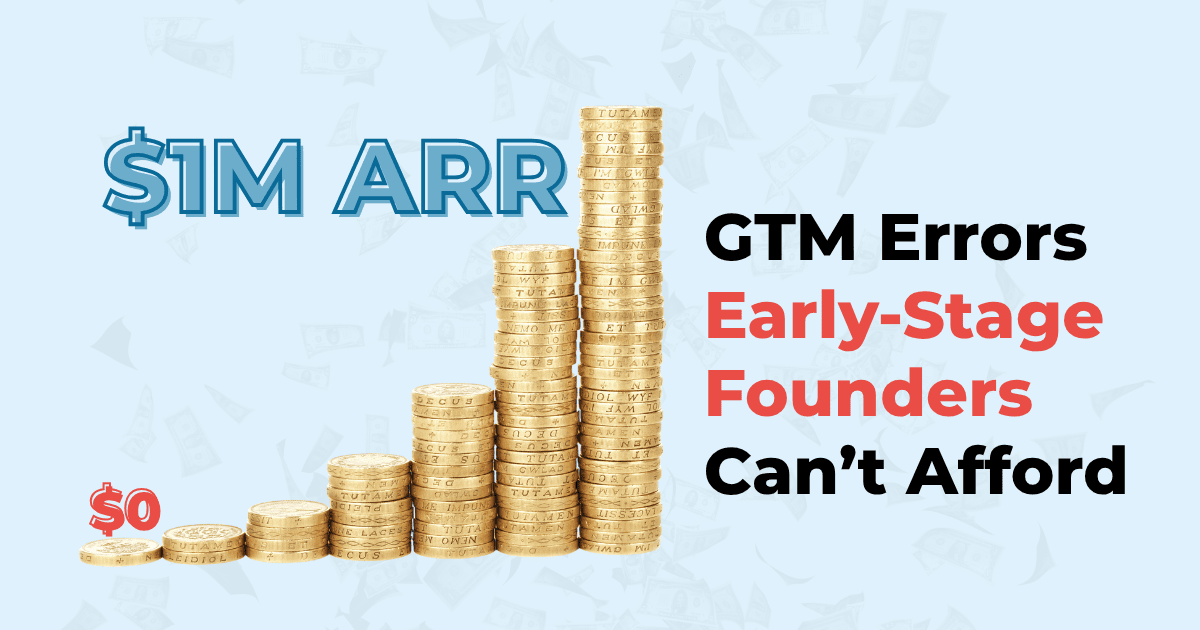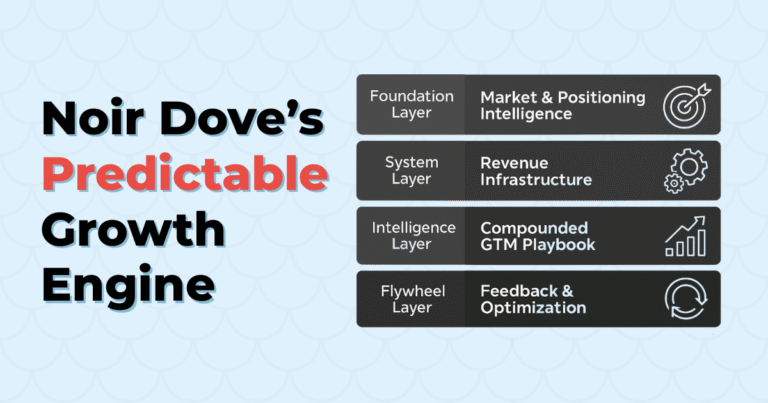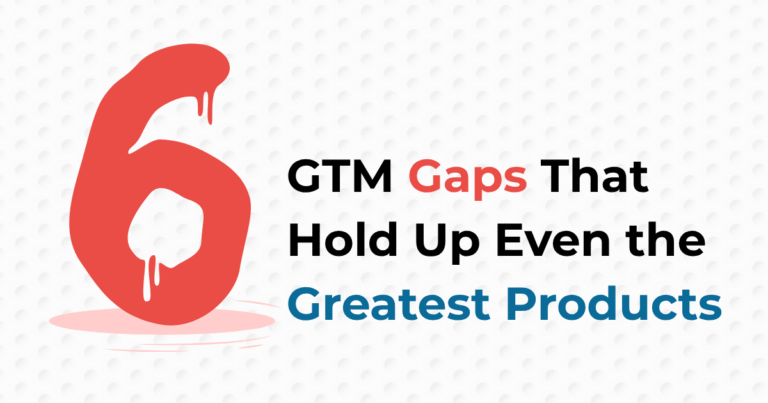For most founders, the $0 to $1M ARR journey is the toughest part of building a company. It’s where concept meets reality, and execution kills or fuels momentum.
The irony? Most startups don’t fail due to the product. They fail due to go-to-market (GTM) errors that kill traction, burn runway, and drain founders.
If you’re in the early stage, here are the largest GTM pitfalls to sidestep, and what to do instead.
KEY TAKEAWAYS
- GTM System > Product: Your system determines success. GTM discipline creates the predictable revenue investors want.
- The 6 Fixable Errors: GTM failure is traceable to six gaps (ICP, Messaging, Sales Process, Metrics, etc.). They are all fixable.
- Prioritize the ‘Who’: Fix ICP Misalignment first. Never lead with features; lead with urgent pain and the cost of inaction.
- Discipline Over Chaos: Stop “Spray-and-Pray.” Focus on 1-2 repeatable motions and align metrics on revenue, not vanity.
- Retention Fuels Growth: Close the Post-Sale Loop early. Retention is the true compounding growth engine.
Error 1: ICP Work Skipped
Most founders assume their product can “work for everyone.” But in practice, selling to everyone equates to selling to no one.
Trap: Ambitious ICP definitions such as “SMBs with 50–200 employees.”
➔ Impact: Sales cycles languish, demos fall flat, and you waste time on prospects who were never actual buyers.
➔ Fix: Drill down to your Serviceable Customer Profile (SCP) — that top 20% of the market with the most acute pain and highest adoption velocity.
Startups with a clearly defined ICP have 2–3 times the chance of success and more rapid scaling (HubSpot).
Error 2: Starting with Features Rather Than Pain
Founders are fond of their product’s features. But customers don’t buy features — they buy solutions to immediate pains.
Snap: “Our solution automates tasks.”
➔ Impact: Buyers don’t “get it” or aren’t urgent.
➔ Fix: Story about the cost of inaction. Instead of listing features, speak to the risk or lost revenue of not addressing the pain
Gartner research indicated that buyers were 2.8x more likely to select a vendor whose messaging clearly articulates value over features.
Error 3: Spray-and-Pray Demand Gen
Early founders will attempt every channel simultaneously: LinkedIn, cold email, ads, webinars, content. What happens? A ton of noise, very little signal.
Trap: Flipping between channels monthly.
➔ Impact: No repeatability, no compounding impact.
➔ Fix: Begin with one or two repeatable demand-gen motions (i.e., outbound + founder-led LinkedIn) and scale only after seeing consistent outcomes.
According to McKinsey research, organizations with concentrated GTM channels grow 15–20% compared to those with diffuse strategies.
Error 4: Over-engineering the Sales Process
At $0–1M ARR, your sales process isn’t supposed to be ideal. It should be consistent.
Typically: Complicated CRM configurations, multi-phase qualification, or excessive playbooks too soon.
➔ Affect: Spending more time “managing” the process than conversing with customers.
➔ Fix: Simple: discovery → demo → close. Employ founder-led sales to learn first-hand from the market before scaling a team.
HBR finds that firms with even a simple structured sales process have 18% higher win rates compared to those without one.
Error 5: Misaligned Metrics
Most founders rejoice over vanity metrics: signups, website traffic, or free trials. But they don’t put food on the table.
Trap: “We got 1,000! signups last month!”
➔ Impact: False sense of traction, no clarity on real growth.
➔ Fix: Focus on revenue-driving metrics:
- Number of qualified meetings
- Pipeline value
- Conversion rate from demo → close
Forrester found that companies with sales + marketing alignment around revenue metrics see 24% faster growth.
Error 6: Ignoring Post-Sale Success
Early founders often obsess over landing new customers but neglect retention. The result? A leaky bucket.
Trap: “Let’s get 100 logos, we’ll fix churn later.”
➔ Impact: High churn destroys MRR and murders investor confidence.
➔ Fix: Even at early stage, establish a lightweight customer success loop: onboarding, periodic check-ins, and case studies.
Bain & Company discovered that growing retention by 5% can increase profits by 25–95%.
The Playbook for $0 → $1M ARR
Here’s the NoirDove framework for early traction:
- Nail Your ICP → Start small, win big.
- Craft Pain-Led Messaging → Position against the cost of inaction.
- Focus Your Channels → 1–2 repeatable demand-gen motions.
- Run Founder-Led Sales → Learn directly from your buyers.
- Align on Revenue Metrics → Measure what moves ARR, not vanity.
- Close the Customer Loop → Retention is the real growth engine.
Final Thought: GTM Discipline > GTM Chaos
At early stage, every decision compounds. Every bad ICP conversation, every low-energy sales call, every burned-out campaign — they chomp into the most valuable asset you’ve got: runway.
But if you remain disciplined — tight ICP, crisp messaging, concentrated channels, revenue-focused metrics, and customer-obsessed mindset — you can reach $1M ARR with clarity rather than chaos.
Because when it comes to the $0 to $1M stage, GTM discipline is the true competitive edge.
Frequently Asked Questions (FAQs) by Early-stage Startup Founders
1. Should I hire my first sales rep before I fix my GTM gaps?
No. Hiring sales reps before you have a repeatable GTM system is the quickest way to incinerate runway. Your first sales process must be founder-led. Learn from the market directly, create a simple sales playbook, and then hire a rep to execute the process you’ve proven works.
2. My product is better than the competition. Why are we still losing deals?
You’re losing deals due to weak messaging (Gap 2). Buyers don’t buy “better technology,” they buy “clearer value.” If you’re leading with features instead of speaking to the immediate cost of inaction for the buyer, you are guaranteeing a long sales cycle and lower win rates.
3. We’re a small team. How can we afford the time to fix all six GTM Gaps?
You can’t afford not to. The fix starts by eliminating the Demand-Gen Scatter (Gap 3). Stop doing “a little bit of everything.” Focus your limited resources on one or two repeatable, high-impact channels until they yield consistent results. This focused discipline saves time immediately.
4. We have a lot of MQLs (Marketing Qualified Leads). Is this good traction?
No, MQLs are a vanity metric if they don’t convert. This points to Misaligned Metrics (Gap 5). Stop celebrating MQLs. Align your entire team on metrics that move revenue: Sales Qualified Meetings and Pipeline Value. If MQLs don’t become pipeline, they’re a distraction, not traction.
5. We’re pre-product-market fit. Should we even worry about retention yet?
Yes, absolutely. Post-Sale Neglect (Gap 6) destroys early growth. The few customers you land are your most valuable source of learning and advocacy. Establishing a simple Customer Success Loop (onboarding, check-ins) early ensures retention, which is the cheapest and most powerful way to drive profit.
At NoirDove, we collaborate with founders to co-create GTM playbooks that cut through chaos in the early stages and establish repeatable revenue systems, so you can scale from $0 to $1M ARR with confidence.




